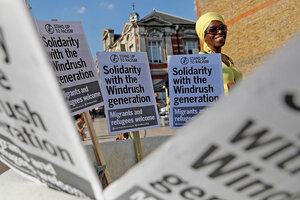Britain's DACA? Children of invited laborers caught in 'Windrush' controversy
They didn't need passports to accompany their laborer parents into Britain from the far corners of the Commonwealth. Now, some 50,000 offspring of the 'Windrush generation' appear caught in a press amid immigration scrutiny.

A woman attends an event in Windrush Square to show solidarity with the Windrush generation in the Brixton district of London, Britain on April 20.
Darren Staples/Reuters
London
They are called “the Windrush generation.”
After World War II, Britain confronted a dual challenge: a shattered infrastructure that needed urgent work and a severe labor shortage. To solve the problem, the British government invited people from from the British Empire and Commonwealth to move to Britain to help rebuild the country. In 1948, the British Nationality Act gave British citizenship to all people living in the United Kingdom and its colonies, and meant they had full rights to enter and settle in the country.
Those who answered the call from the Caribbean are named after the Empire Windrush, the first ship to bring people over – mainly from Jamaica, Trinidad and Tobago, and Barbados. It docked in June 1948, carrying 492 people. Between 1948 and 1971 thousands more came over to work, encouraged by campaigns from successive British governments. Many went on to find work within the National Health Service (NHS), British Rail, and public transport.
Many of them also brought their children, as it wasn’t necessary for children to have their own passports then. Consequently many of the so-called Windrush generation don’t have documentation despite having lived, been schooled, and worked in the UK for most of their lives.
Why have they become the center of controversy?
A scandal has been mounting over the last six months after the Guardian newspaper began reporting cases of people who arrived in the UK as children losing jobs, being denied services such as treatment on the NHS, and facing deportation due to tightening in immigration rules.
One of the first stories to emerge was that of Paulette Wilson, who left Jamaica at the age of 10 in 1968 and has been living in Britain ever since. She received a letter informing her that she was an illegal immigrant and was going to be removed and sent back despite not being back to Jamaica in nearly 50 years. After being sent to a detention center, and then taken to Heathrow Airport, a last-minute intervention by her MP meant she was saved from being deported.
Another which has come to epitomize the scandal has been Albert Thompson (which is not his real name), who was told he would have to pay £54,000 for prostate cancer treatment after he was unable to produce the right documentation, despite having lived in the UK for 44 years.
As more similar stories have emerged, pressure has mounted on the government to address the problem.
Why don't they have the correct paperwork?
There are thought to be an estimated 57,000 residents who could face problems. Many assumed they were British, as they had moved to the UK before the countries they were born in became independent.
Legislation gave Commonwealth citizens who had arrived before 1973 indefinite leave to remain, but the British government did not issue paperwork to those affected nor keep proper records of them. In addition, thousands of Windrush-era landing cards, which are routinely used in immigration decision-making, were destroyed by the Home Office in 2010. Many of this generation have never applied for passports of their own and were put off from going through the naturalization process due to the high expense.
Why are top British politicians embroiled in the scandal?
In 2012, when Theresa May was Home secretary, she ushered in new legislation that required employers, landlords, and the National Health Service to demand evidence of legal immigration status. At the time Ms. May said the aim was to create “a really hostile environment” for unauthorized immigrants. Around the same time, the Home Office launched a campaign with vans that were driven around diverse neighborhoods and were emblazoned with the words “Go home or face arrest,” which sparked outrage.
The effect on the Windrush generation is likely to have been an “unforeseen consequence” of that approach, according to a former Home Office official. And Labour Party leader Jeremy Corbyn has accused May, now prime minister, of being personally responsible for the Windrush generation’s problems.
On April 29, Amber Rudd resigned as Home secretary after receiving a barrage of calls to quit over her handling of the crisis, despite having issued an unprecedented five apologies. What had drawn the most criticism was the beleaguered Ms. Rudd’s insistence that she knew nothing of Home Office targets for immigration removals, which was later undermined by documents.
Many critics say that now the prime minister must answer questions on how the scandal was allowed to happen. Supporters of May, who has also apologized, agree she is far more vulnerable now that Rudd has fallen on her sword.
How can the migrants’ situation be resolved?
About two weeks before her resignation, Rudd announced the creation of a new Home Office task force dedicated to ensuring that long-term British residents who were born in the Commonwealth will no longer be classified as unauthorized immigrants. She also announced a series of measures, including the waiver of citizenship and naturalization fees and the setting up of an independently run compensation program.
In her resignation letter, Rudd said both the task force and the compensation program were working well. It is expected these will continue under the new Home secretary, Sajid Javid.
Diane Abbott, the shadow Home secretary, says more needs to be done and has called for the 2014 Immigration Act to be repealed. Also, more than 200 members of Parliament have written to May urging her to enshrine in law promises made to Windrush generation migrants so they are protected under future governments.
[Editor's note: This story was updated with the resignation of Home Secretary Amber Rudd.]

